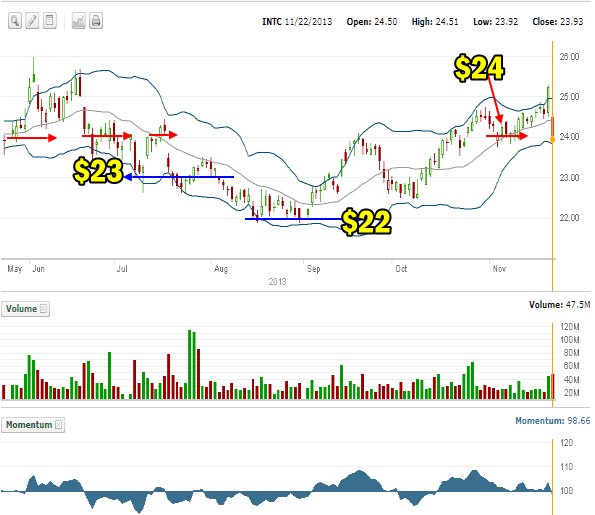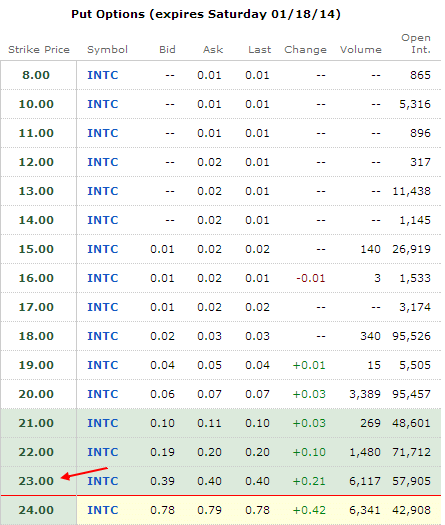The collapse this morning in Intel Stock is certainly not unprecedented for this stock. Intel Stock has had quite the checkered past. Even now if I look at analysts’ ratings there are 2 sells, 5 underperform ratings, 21 hold ratings, 9 buy ratings and 6 strong buy ratings on Intel Stock.
Intel stock cannot seem to get past the $25 valuation. Part of the reason is the outlook from Intel Corp itself which basically believes 2014 revenue and earnings will be pretty much the same as 2013. This is disappointing and while many analysts believe it is too conservative on the part of Intel, as a small investor I have no plans to bet against what the company itself is telling investors.
The lack of a strong outlook for Intel could play strongly into more Put Selling opportunities. The problem though will be a decline in volatility if the stock starts to trend sideways with a slight bias down or up and thereby declining put option premiums.
But this lack of volatility and declining put premiums can play well into one particular strategy I call the Cash Cushion strategy.
Before explaining the cash cushion strategy, let’s look at Intel Stock support levels over the past 6 months.
Intel Stock Support Levels
Looking at the last 6 months I can see there is some support at $24. There was a lot more support earlier this year in Intel Stock as you can see in the chart. However once the $24 support broke the stock quickly fell to $23 and then down to $22.
Looking at volume we can see that a lot of investors are actually in the stock right around $23. This should help Intel Stock and makes the $23 probably the premium put strike for selling whenever the stock dips below $24. The chance of being assigned at $23 is slim looking at the chart below, but also it would be easy to work out of the stock if assigned at the $23 level.
I included momentum in the chart below to show how momentum was already declining in November and the last little run-up to just over $25 had no strength at all. You can see this in the momentum indicator. That kind of push higher in the stock, without the support of any momentum is a clear signal that the stock will fall back. A very good opportunity existed there for buying put options, which is something I rarely do. I do not like owning an asset that erodes in value based on time. In other words if I buy a put and the stock does not fall but moves sideways the value of my put option does decline as it nears expiry. I much prefer being on the other side of the trade where I have sold the put option and the value erodes as it reaches expiry.

Put Selling Strategy For Intel Stock
With $23 being a prime Put Selling strike, the problem is the premiums offered are only about half a percent one month out with the stock up around the $24 value. The stock needs to fall back to $23.50 to drive up the option premium at the $23 strike with one month to expiry. Selling Puts for .13 cents for one month out expiry at the $23 strike really does not make a lot of sense to me. I am risking my capital for abot half a percent. The stock could easily fall lower and the $23 put strike I sold for 13 cents will be worth a lot more if the stock keeps falling.
Enter The Cash Cushion Put Selling Strategy
The cash cushion Put Selling strategy is a method I have used many times to increase earnings through Put Selling and provide superior safety. I calculate how much capital I am willing to risk and then decide on my course for Put Selling. For example, in my example below I am using $69,000.00. You would adjust this trade depending on the amount of capital you would want to risk.
The whole idea of the cash cushion strategy is to start with a small number of put contracts and then only sell more if there is an increase in put premiums by 25%. Let’s take a look.
For example I sold today 5 of the January 18 2014 put option for .40 cents at the $23 strike. This gets a position started. If the stock falls lower over the coming weeks, I will sell another 5 put options in January at $23 put strike but ONLY if the put premium is up another 25%. This means .50 cents.
Then if Intel stock falls lower I will sell another set of 5 put options at the $23 strike but only if it increases another 25% which would be $0.63 cents.
This would mean half of my $69,000 is committed and I would stop there and then look for opportunities in February but again only when there is a put option premium increase.
If Intel Stock moves lower I then start to sell the Feb 21 2014 option expiry at $23 strike. I start with 5 put contracts and increase it each time the put premium moves up 25%. If it does not move higher I do not sell more puts.
Below you can see the January 18 2014 put strikes and their premiums as of 1:30 on Nov 22 2013.

After using Strategy 1 for many years the thing I like best is that I am scaling into the put strikes but only when there are increases in put premiums. Should something unanticipated happen, which can definitely happen with stocks, then I am earning good premiums as the stock falls, but if assigned I am scaling myself lower into the stock.
For example let’s say the stock falls to $22.50 after I have sold my 15 naked puts for January and started selling naked puts into February.
Theoretically here is what the trade might look like:
Intel stock at $23.92: Original 5 naked puts at $23 for January expiry sold for .40 cents
Intel Stock at $23,65: Second set of 5 naked puts at $23 for January expiry sold for .50 cents
Intel Stock at $23.10: Third set of 5 naked puts at $23 for January expiry sold for .63 cents
Total amount of capital committed to trade = 1500 X $23 = $34500.00
Total income earned = $765.00
Cost basis in stock = $34,500 less $765 = $33735.00 divided by 1500 shares = $22.49.
—————-
Meanwhile I am also now selling the February 2014 $23 naked puts.
Intel Stock at $23.0o: First set of 5 naked puts at $23 for February expiry sold for $.75
Intel Stock at $22.50: Second set of 5 naked puts at $23 for February expiry sold for $0.94 cents (25% more)
Intel Stock at $22.15: Third set of 5 naked puts at $23 for February expiry sold for $1.18 (25% more)
Total amount of capital now committed to trade = 3000 X $23 = $69,000.00
Total Income earned = $2200.00
Cost basis in stock = $69,000 less $2200 = $66,800.00 divided by 3000 shares = $22.26
—————
This of course is only theory, but it shows the potential to earn income and protect against a steeper decline in the stock. As well, I find that often my January puts will be bought back for less than I sold them for and rolled into the third month, which would be March. In this manner more and more income is earned and the safety cushion becomes bigger each time put options are sold and the income earned is stuffed into the cash cushion. Eventually this cash cushion is so large that a very steep decline would have to occur to damage the capital invested.
—————
The Cash Cushion Put Selling Strategy Summary
It is difficult to show how Cash Cushion Put Selling strategy functions except to show how it has worked in the past. I will post another such trade shortly to show how this cash cushion strategy functions on a stock like Intel Stock.
Internal Intel Stock Links
Members Only Articles On Intel Stock
Review 2013 Intel Stock Trades
Review 2012 Intel Stock Trades
Review 2011 Intel Stock Trades
Review 2010 Intel Stock Trades
All Intel Stock Posts With Excerpts

